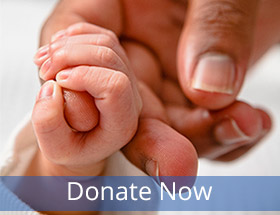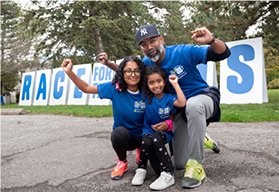“Rehabilitation is a team effort,” says Dr. Marc Jeschke, director of Sunnybrook’s Ross Tilley Burn Centre; and Elijah Crothers has played many roles on that team — from receiving care at the burn centre and St. John’s Rehab to helping Sunnybrook fine-tune some of the most cutting-edge artificial limb control technology.
The 24-year-old was a power utility worker replacing electrical poles when his hands, momentarily unprotected, came into contact with a live wire. The impact was almost instantaneous. His injuries were so severe that when he arrived via ambulance at Sunnybrook’s Ross Tilley Burn Centre, the difficult decision was made to amputate both his arms to save his life.
Where he once enjoyed activities like snowmobiling, fishing and motocross biking, Elijah faced the prospect of having to relearn how to do just about everything.
While most people would be gloomy about such a grim prognosis, Elijah counts himself among the lucky ones.
Elijah with his dog Tilley, named in honour of the Ross Tilley Burn Centre at Sunnybrook.
That’s because up to 1,000 people a year in Ontario are injured in electrical accidents, and there’s still much we don’t understand about the effect of electricity on the body.
But the Ross Tilley Burn Centre is one of the leading institutions in the world both for helping burn victims using existing treatments, and developing new ones. With generous donor support, the team is exploring how to 3D print skin cells from a patient’s stem cells.
A model patient
With his natural optimism and his vigorous health and strength, Elijah has been a model patient and an enthusiastic participant not only in his own treatment, but also in helping to improve treatments for those who come after him.
“Elijah has that farm mentality of figure it out, fix it, and get on with it,” says Shane Glasford, lead of the custom prosthetics lab at the Sunnybrook Centre for Independent Living, who outfitted him with a series of custom prostheses since the accident happened.
Elijah at work on his farm.
He means that literally. After the accident, Elijah and his partner Felicia moved to a farm in Campbellford, Ont., which once belonged to his grandparents, and decided to turn the property into a functioning farm again. His exuberance was so great that he actually broke the original prostheses he was fitted with because he was so active around the farm.
Over the years, Elijah and the team at Sunnybrook have worked together to learn more about what he and his new arms can do.
Advancing new intuitive technology
Elijah’s early prosthetic arms were affixed with hooks, but the latest version features multiple sensors and pattern recognition technology that give him the ability to manipulate fingers independently and even an opposable thumb. The technology only recently made the leap from research to commercial product. It is so new the team had to wait a few weeks to get the elbows approved by Health Canada. “The cosmetic factor is huge mentally,” says Elijah.
A grateful beneficiary of this technology, Elijah is giving back by helping teach researchers about how they work in real life. Thanks to the latest model utilizing CoApt Engineering’s pattern recognition software, he can move his hands just by thinking about it.
“It’s a lot more intuitive,” says Elijah, who was able to get the elbow to bend, hand to open and wrist to turn to grasp a cup within 15 minutes of his first time using the system — actions that would have taken weeks or months with the old style.
Elijah feeds the chickens, a daily routine.
Now Elijah is finessing how he loads his wood-burning furnace with logs, folds laundry and cleans the kitchen before moving onto more rigorous outdoor chores. Plus, he is relishing the ability to feed his beloved dog Tilley, named for the burn centre that saved his life.













